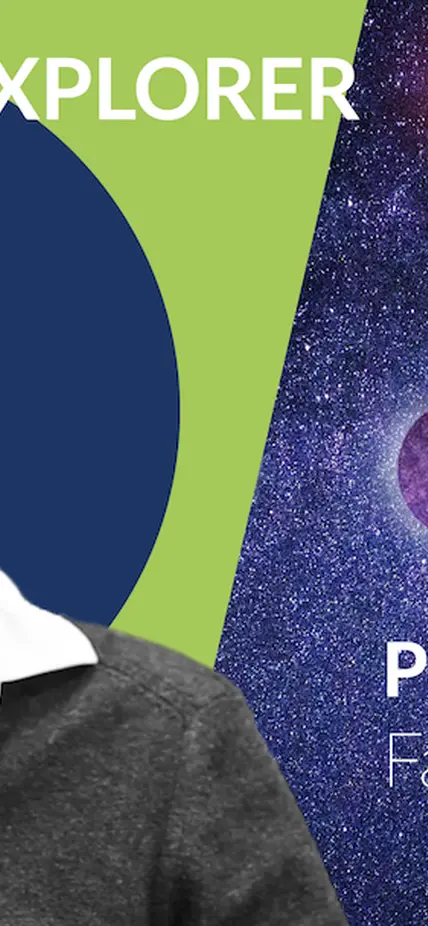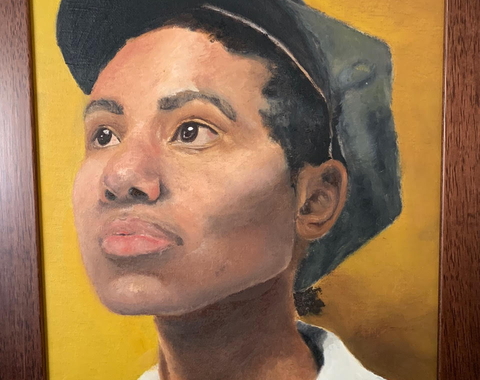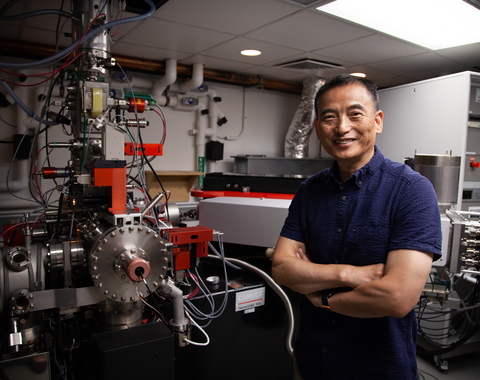Thomas Edison invented the first successful lightbulb after thousands of failed trials. His discovery of that perfect incandescent carbon filament literally lit up the world. But what if he had had a recipe to speed up the process?
That recipe is exactly what Carnegie Postdoctoral Fellow Li Zhu aims to bring to future engineers, scientists, and inventors! As a computational materials scientist, Zhu uses computer models to predict new materials before they exist, removing much of the need for trial and error. His models provide a map that allows Carnegie’s experimental scientists to more easily create new materials.
Early in 2020, this computational prediction method led to the creation of a long-sought-after class of “superdiamond” called a carbon clathrate. These networks of diamond-like carbon cages can hold other elements inside of their structure, allowing their mechanical and electronic properties to be tuned and adjusted. Without the help of Zhu’s roadmap, there is no telling when this material would have been synthesized.
Before the COVID-19 pandemic had everyone working from home, we sat down with Li Zhu for an interview about this recent work. Below you will find an edited transcript of our interview, plus some bonus material that we had to cut out of the video for time.
Enjoy!
Carnegie Science (CS): Please introduce yourself. Who are you and what do you do at the Carnegie Institution for Science?
Li Zhu (LZ): I’m Li Zhu and I’m a postdoc at the Carnegie Earth and Planets Laboratory. Before I came here, I was a postdoc at Basel University in Switzerland. Before that, I got my Ph.D. in Physics from Jilin University in China.
I’m a computational materials scientist, So, my research mainly focuses on the development of computational methods to design and discover new materials. I apply these methods to predict new materials, especially materials under high pressures.
CS: What would you say is the coolest part of your research?
LZ: The coolest part of my research is that we can design a new material on a computer instead of testing it in the lab. We can know its properties and its functions even before it exists!
CS: What brought you to the Earth and Planets Laboratory?
LZ: As I said, I am a computational materials scientist. Pressure is very important to create the materials that are not accessible at ambient pressure. Carnegie is a leading place, and a very famous place, for high-pressure study. So, that’s why I’m here.
CS: How did you get interested in computational materials science?
LZ: Actually, I have wanted to be a scientist since I was a little boy!
Materials are so important for our society. When I was very young, I heard a story about the discovery of the lightbulb by Thomas Edison. At that time, I felt that I wanted to be the one to discover new materials!
After I started my Ph.D., I realized that materials discovery is essential. But also challenging. You know, when different chemicals are mixed together, sometimes they will react to form new materials, but sometimes they don’t! I wanted to contribute to developing a method of material discovery much faster.
This is how I got into this area, computational materials discovery.
CS: How did people find new materials before this computational method?
LZ: A century ago, the way people found materials was a very long and costly process. For example, Edison tested more than 3,000 materials for his lightbulb. But we wanted to do it much faster. So, we developed a new method to theoretically identify which materials are good and that can be made in the lab. So, that’s what I’m doing here.
CS: Why is the new development of new computational tools important?
LZ: We are now able to predict the materials and we can predict their properties. But, there is a huge gap between the prediction and their synthesis. We have a lot of materials that we can predict, but not a lot of them which can be made. A lot of predicted materials turn out to be unstable. This computational method will be very helpful to inform the scientists which structures can be made and which cannot.
Li Zhu shows off a 3D printed carbon clathrate structure
CS: Recently, your computational method helped predict and ultimately synthesize the first carbon-based clathrate What is a clathrate?
LZ: Essentially, a clathrate is a kind of cage-like structure. It has a host structure and it can hold an atom inside that cage. If we put different elements in this cage, the material will have different properties.
CS: How did you create the first carbon clathrate?
LZ: Clathrate structures exist a lot in nature and there's a lot of different clathrates such as silicon clathrates, germanium clathrates, water clathrates, and hydrogen clathrates. But, no carbon-based clathrates existed before.
The carbon-based clathrate was predicted to have some excellent properties, like the potential for superconductivity. Scientists attempted to create a carbon-based clathrate more than 50 years ago. But, no carbon clathrate was made.
We used a structure prediction method, which we developed, to predict the first stable carbon clathrate. Then, my colleagues used that prediction to synthesize the clathrate in the lab under very high pressures. So, this is the first carbon clathrate in the world. This material is as hard as diamond and has the potential to act as a superconductor or an insulator depending on which atoms we put in the cage.
CS: So what elements were you able to trap in this clathrate?
LZ: Potentially it can trap a lot of different elements. Currently, we have successfully made two different clathrates. We can trap a strontium atom in the cage, which turns the clathrate into a superconductor. We have also made an insulator by putting lithium atoms inside of this cage.
CS: Why do you think the creation of the first carbon clathrate is important?
LZ: For one, the realization of this first carbon clathrate will open up a new way to study and synthesize carbon-based materials.
You know, our world has a lot of challenges. For example, we are facing the problem of energy shortage. Developing a superconductor can help us to save a lot of energy and ultimately can make the world better.
CS: What are some challenges for computational materials science?
LZ: I do a lot of predictions for materials under high pressure. But some materials, new materials, can only exist under very high pressures, such as larger than 2,000 GPa. So, currently, it’s very hard to make them in the lab. I hope in the future we will have a chance to make them.
CS: What’s next for your research?
LZ: I would like to build a materials map to establish a navigation system for materials synthesis. You know, as I mentioned before, there are a lot of materials that have been predicted. Many of them have very exciting properties, but most of these predicted materials have a metastable structure, which means it’s very challenging to synthesize them.
So, the ability to control and design the synthesis of metastable structures would lead to extraordinary discoveries.
CS: Where do you see your field in 100 years or so?
LZ: It’s always hard to make predictions, but I believe that the study of new materials will remain an important topic. So, I hope in the future we can discover materials by “wish.”
When I say “wish” I mean that if a scientist or engineer wants a material with specific properties, he can find a recipe to make it easily.
CS: If you could meet one of your science icons, who would it be?
LZ: Erwin Schrodinger, because he is one of the scientists who built the foundation of quantum mechanics. Quantum mechanics has changed our world dramatically. And basically all of my work is based on his work.
CS: Finally, if you weren’t a scientist. What would you be doing?
LZ: I might’ve been a painter because it’s challenging and very fun. And, from my point of view, painting lets me see the world through different eyes! I love painting



